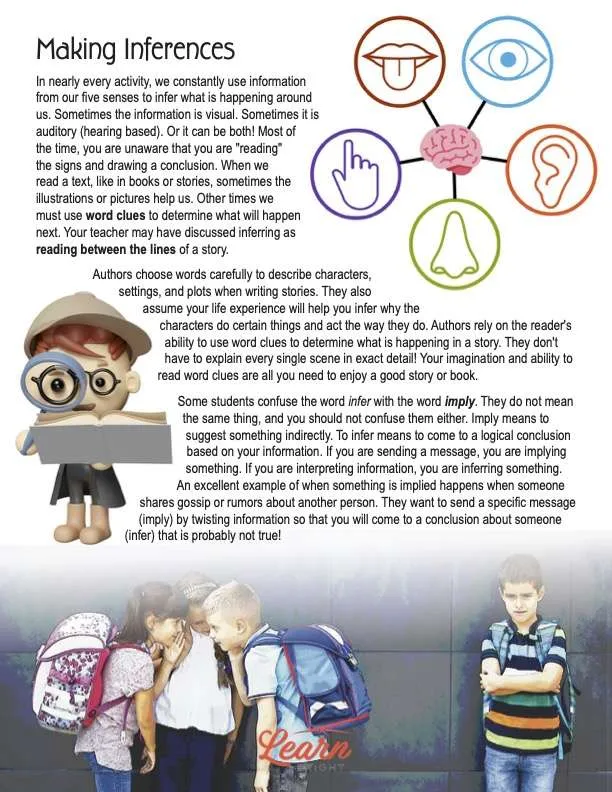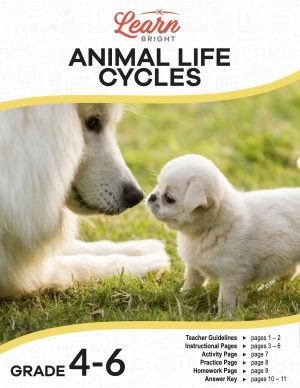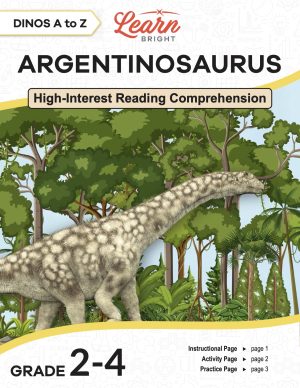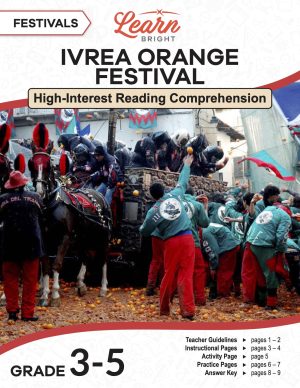Description
What our Making Inferences lesson plan includes
Lesson Objectives and Overview: Making Inferences teaches students how to refer to details in a text to explain what the text says explicitly. They will differentiate between infer and imply, infer and predict, and literal and inferred (inferential). Students will also refer to more information in a text to make inferences or predictions. This lesson is for students in 3rd grade, 4th grade, and 5th grade.
Classroom Procedure
Every lesson plan provides you with a classroom procedure page that outlines a step-by-step guide to follow. You do not have to follow the guide exactly. The guide helps you organize the lesson and details when to hand out worksheets. It also lists information in the green box that you might find useful. You will find the lesson objectives, state standards, and number of class sessions the lesson should take to complete in this area. In addition, it describes the supplies you will need as well as what and how you need to prepare beforehand. The equipment you’ll need for this lesson includes whiteboards, writing materials, materials for anchor charts, paper, and the handouts. This lesson requires 10 or more bags with different objects in each one.
Options for Lesson
Included with this lesson is an “Options for Lesson” section that lists a number of suggestions for activities to add to the lesson or substitutions for the ones already in the lesson. Teaching inferential skills to young students can be a challenge. However, research shows that students proficient in inferential comprehension can grasp more complex texts. One option for the lesson is to begin by showing different images (historical images are great). Ask students what is happening in the image and then provide the students with an explanation. Connecting images to text is part of the process of being able to infer.
Teacher Notes
The teacher notes page includes a paragraph with additional guidelines and things to think about as you begin to plan your lesson. It explains that this lesson will help students learn to read between the lines and look for word clues to provide evidence for their inferences. This page also includes lines that you can use to add your own notes as you’re preparing for this lesson.
MAKING INFERENCES LESSON PLAN CONTENT PAGES
What Is an Inference?
The Making Inferences lesson plan contains three content pages. What is an inference? Great question! Inference comes from the word infer. Infer means to assume, figure out, or guess something using the information in your reading text. You may be thinking that sounds hard. But the truth is that we are always using inferential thinking and inferring stuff! In the image above, we might infer that the boy is laughing because he is reading something funny. He may also be laughing at something he is looking at.
As another example, say you are watching a video. The actor is a soccer player who is crying. In the scene before, the actor was in a championship soccer match that just concluded. So, maybe the actor lost the championship and is unhappy. Maybe the actor won the championship and is crying tears of joy. Or the actor is injured, and the pain hurts. These are all logical inferences or guesses as to what is happening based on the clues you have.
In nearly every activity, we constantly use information from our five senses to infer what is happening around us. Sometimes the information is visual. Sometimes it is auditory (hearing based). Or it can be both! Most of the time, you are unaware that you are “reading” the signs and drawing a conclusion. When we read a text, like in books or stories, sometimes the illustrations or pictures help us. Other times we must use word clues to determine what will happen next. Your teacher may have discussed inferring as reading between the lines of a story.
Authors choose words carefully to describe characters, settings, and plots when writing stories. They also assume your life experience will help you infer why the characters do certain things and act the way they do. Authors rely on the reader’s ability to use word clues to determine what is happening in a story. They don’t have to explain every single scene in exact detail! Your imagination and ability to read word clues are all you need to enjoy a good story or book.
Imply v. Infer, Predict v. Infer, Literal v. Inferred
Some students confuse the word infer with the word imply. They do not mean the same thing, and you should not confuse them either. Imply means to suggest something indirectly. To infer means to come to a logical conclusion based on your information. If you are sending a message, you are implying something. If you are interpreting information, you are inferring something.
An excellent example of when something is implied happens when someone shares gossip or rumors about another person. They want to send a specific message (imply) by twisting information so that you will come to a conclusion about someone (infer) that is probably not true!
Inferences are not predictions. Yes, these two concepts are related, but just as implying differs from inferring, predicting is also different. A prediction is a guess about what happens next in the future. An inference relates to what’s happening now using facts. In the example of the actor playing the role of a soccer player, we might infer that he is crying because he lost the championship game. If we were predicting, we could say he lost the soccer championship but will be awarded the good sportsmanship award after the match. There is no evidence to suggest that will happen. But there is visible evidence to support the inference of why the actor is crying.
Here is one other thing you need to know to help you understand inferences: inferred is the opposite of literal. Literal means the evidence perfectly supports the conclusion, and there is no doubt. It is what it is. An easy example is that is one plus one equals two. There is no doubt about the meaning or the conclusion—one plus one equals two.
Tools to Help You Make Inferences
The lesson lists a number of tools that students can use to help them craft their inferences. Look for word clues in the sentences before the one you are making the inference from. Clues are most often verbs or words that relate to the five senses. Think about the character. How did the character respond in other situations? What are the character’s traits? Is your inference consistent with how the character behaves?
Apply your personal experience. What would you do if faced with the same situation? Is your inference logical? The evidence should fit with your conclusion. Study the pictures or illustrations. What clues do you observe in the pictures? They will nearly always match what the character is feeling or doing. Finally, inferences are written in the present. What’s happening now at this moment in time?
MAKING INFERENCES LESSON PLAN WORKSHEETS
The Making Inferences lesson plan includes three worksheets: an activity worksheet, a practice worksheet, and a homework assignment. Each one will help students solidify their understanding of the lesson material in different ways. You can refer to the guide on the classroom procedure page to determine when to hand out each worksheet.
INFER AND PREDICT ACTIVITY WORKSHEET
For the activity, students will study three photos. First, they will infer what is happening in the picture. Then they will predict what will happen. The worksheet reminds them that inferences should be in present tense. And students will write their predictions in future tense.
MAKING INFERENCES PRACTICE WORKSHEET
The practice worksheet requires students to make inferences based on evidence in a statement. It lists a total of nine statements for students to look at. Students will write their answers in the right column next to each statement.
CREATE THE EVIDENCE HOMEWORK ASSIGNMENT
Opposite to the practice worksheet, the homework assignment requires students to create a scenario with evidence that would lead to the inferences provided. There are six inferences in the right column. Students will write the evidence to support the inference in the left column.
Worksheet Answer Keys
This lesson plan includes answer keys for both the practice worksheet and the homework assignment. Given the nature of these assignments, the answers provided are sample responses. Students answers will vary. You can allow them to use these as guidance. If you choose to administer the lesson pages to your students via PDF, you will need to save a new file that omits these pages. Otherwise, you can simply print out the applicable pages and keep these as reference for yourself when grading assignments.









